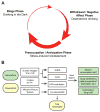The Corticotropin Releasing Factor Receptor 1 in Alcohol Use Disorder: Still a Valid Drug Target?
- PMID: 28940382
- PMCID: PMC5711524
- DOI: 10.1111/acer.13507
The Corticotropin Releasing Factor Receptor 1 in Alcohol Use Disorder: Still a Valid Drug Target?
Abstract
Corticotropin releasing factor (CRF) is a neuropeptide that plays a key role in behavioral and physiological responses to stress. A large body of animal literature implicates CRF acting at type 1 CRF receptors (CRFR1) in consumption by alcohol-dependent subjects, stress-induced reinstatement of alcohol seeking, and possibly binge alcohol consumption. These studies have encouraged recent pilot studies of CRFR1 antagonists in humans with alcohol use disorder (AUD). It was a great disappointment to many in the field that these studies failed to show an effect of these compounds on stress-induced alcohol craving. Here, we examine these studies to explore potential limitations and discuss preclinical and human literature to ask whether CRFR1 is still a valid drug target to pursue for the treatment of AUD.
Keywords: Alcohol Craving; Alcohol Seeking; Alcohol Use Disorder; Corticotropin Releasing Factor Receptor Type 1; Neuropeptide.
Copyright © 2017 by the Research Society on Alcoholism.
Conflict of interest statement
Conflicts of Interest:
The authors have no financial conflicts of interest to declare.
Figures

Similar articles
-
Corticotropin-releasing factor acting on corticotropin-releasing factor receptor type 1 is critical for binge alcohol drinking in mice.Alcohol Clin Exp Res. 2012 Feb;36(2):369-76. doi: 10.1111/j.1530-0277.2011.01610.x. Epub 2011 Sep 6. Alcohol Clin Exp Res. 2012. PMID: 21895713 Free PMC article.
-
Pre-clinical evidence that corticotropin-releasing factor (CRF) receptor antagonists are promising targets for pharmacological treatment of alcoholism.CNS Neurol Disord Drug Targets. 2010 Mar;9(1):77-86. doi: 10.2174/187152710790966605. CNS Neurol Disord Drug Targets. 2010. PMID: 20201818 Free PMC article. Review.
-
The role of corticotropin-releasing factor in the median raphe nucleus in relapse to alcohol.J Neurosci. 2002 Sep 15;22(18):7844-9. doi: 10.1523/JNEUROSCI.22-18-07844.2002. J Neurosci. 2002. PMID: 12223536 Free PMC article.
-
Behavioral, biological, and chemical perspectives on targeting CRF(1) receptor antagonists to treat alcoholism.Drug Alcohol Depend. 2013 Mar 1;128(3):175-86. doi: 10.1016/j.drugalcdep.2012.12.017. Epub 2013 Jan 5. Drug Alcohol Depend. 2013. PMID: 23294766 Free PMC article. Review.
-
Sex differences in corticotropin-releasing factor receptor-1 action within the dorsal raphe nucleus in stress responsivity.Biol Psychiatry. 2014 Jun 1;75(11):873-83. doi: 10.1016/j.biopsych.2013.10.013. Epub 2013 Oct 23. Biol Psychiatry. 2014. PMID: 24289884 Free PMC article.
Cited by
-
Neuropeptidergic regulation of compulsive ethanol seeking in C. elegans.Sci Rep. 2022 Feb 2;12(1):1804. doi: 10.1038/s41598-022-05256-1. Sci Rep. 2022. PMID: 35110557 Free PMC article.
-
Evidence for independent actions of the CRF and ghrelin systems in binge-like alcohol drinking in mice.Prog Neuropsychopharmacol Biol Psychiatry. 2025 Apr 2;138:111341. doi: 10.1016/j.pnpbp.2025.111341. Epub 2025 Mar 24. Prog Neuropsychopharmacol Biol Psychiatry. 2025. PMID: 40139339
-
Bed nuclei of the stria terminalis modulate memory consolidation via glucocorticoid-dependent and -independent circuits.Proc Natl Acad Sci U S A. 2020 Apr 7;117(14):8104-8114. doi: 10.1073/pnas.1915501117. Epub 2020 Mar 19. Proc Natl Acad Sci U S A. 2020. PMID: 32193346 Free PMC article.
-
Corticotropin Releasing Hormone Signaling in the Bed Nuclei of the Stria Terminalis as a Link to Maladaptive Behaviors.Front Neurosci. 2021 Mar 19;15:642379. doi: 10.3389/fnins.2021.642379. eCollection 2021. Front Neurosci. 2021. PMID: 33867924 Free PMC article. Review.
-
Roles of corticotropin-releasing factor signaling in the lateral habenula in anxiety-like and alcohol drinking behaviors in male rats.Neurobiol Stress. 2021 Sep 13;15:100395. doi: 10.1016/j.ynstr.2021.100395. eCollection 2021 Nov. Neurobiol Stress. 2021. PMID: 34568522 Free PMC article.
References
-
- Anton RF, Oroszi G, O’Malley S, Couper D, Swift R, Pettinati H, Goldman D. An Evaluation of μ-Opioid Receptor (OPRM1) as a Predictor of Naltrexone Response in the Treatment of Alcohol Dependence: Results From the Combined Pharmacotherapies and Behavioral Interventions for Alcohol Dependence (COMBINE) Study. Arch Gen Psychiatry. 2008;65:135–144. - PMC - PubMed
-
- Asan E, Yilmazer-Hanke DM, Eliava M, Hantsch M, Lesch KP, Schmitt A. The corticotropin-releasing factor (CRF)-system and monoaminergic afferents in the central amygdala: investigations in different mouse strains and comparison with the rat. Neuroscience. 2005;131:953–967. - PubMed
Publication types
MeSH terms
Substances
Grants and funding
LinkOut - more resources
Full Text Sources
Other Literature Sources
Medical

